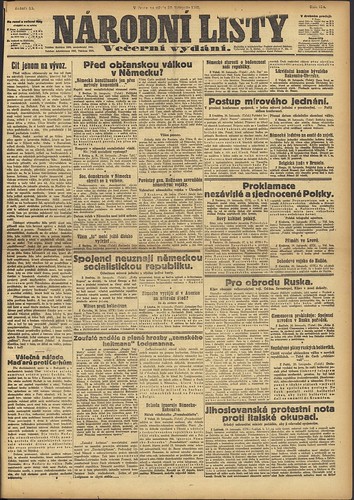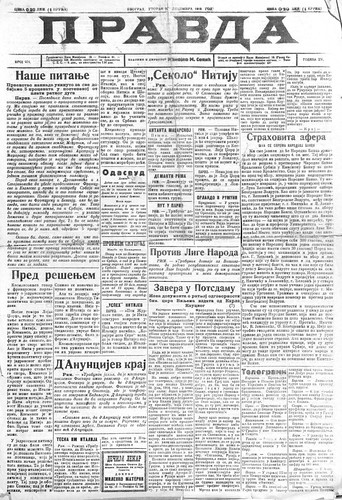This week one hundred years ago, on 28th of June 1914, Archduke Franz Ferdinand of Austria was assassinated. This event triggered the outbreak of WWI one month later. How did European newspapers of the time cover the crucial events and the political opinions in this terrible war? Did the news travel fast? Europeana Newspapers has gathered historic newspaper material to illustrate how different European newspapers reported on WWI. This week we’ll publish a series of three articles, each covering one important moment in WWI. Today in the third and last article of our series, in which we cover the Versailles Treaty.
On 18 January 1919 the Peace Conference, destined to unfold a new peace settlement after the Great War, commenced in Paris. The date was certainly not chosen by chance, since 48 years earlier, Wilhelm I was proclaimed emperor of the new German Empire at that very date.[1] The conference officially concluded about a year later, with the inaugural General Assembly of the League of Nations – the predecessor of today’s United Nations. Arguably, the most important event during this time was the conclusion of the peace treaty with Germany on 28 June 1919, the so-called Treaty of Versailles. The most important decisions, considerations and meetings were held before that date. Although after this event, the conference was more like what Margaret Macmillan described as: “…a theatrical production whose stars had gone”[2] because the assembled head of states had left Paris, work on other peace treaties continued. Austria signed its peace treaty in Saint-Germain on 10 September 1919 and Bulgaria’s treaty was signed in Neuilly on 27 November 1919, while the treaties with Hungary signed on 4 June 1920 in Trianon and Turkey signed on 10 August 1920 in Sèvres were prepared at the conference but concluded after its conclusion.
Those treaties, especially the one concerning Germany, have been contested from their moment of signing. In retrospective their objective to find a durable peace settlement for the European continent was not fulfilled, as even some contemporaries sensed it. A British diplomat, for example, said: “We came to Paris confident that the new order was about to be established, we left it convinced that the new order had merely fouled the old.”[3]
But there is another aspect to the conference as well – it was a great media event. “Five hundred journalists were on hand to record and broadcast the proceedings at a time when publicity was the exception and not the rule.”[4] wrote Zara Steiner about the event. Therefore we will take a look at how the Peace Conference was presented in contemporary newspapers all over Europe.
What might be obvious today was not so much at that time. Although an occasion of world-wide significance, with objectives and decisions that might have been centred on Europe but were sensible across the planet, the reports were centred on national perspectives. The reason is to be found in the outcome of World War I itself – At first glance the continent was cleared of multi-national empires and a number of smaller states gained independence. Though at a closer look this is not that obvious because about 30 million people lived in states in which they constituted an ethnic minority.[5]

Therefore, the, at the time Czechoslovak newspaper Národní Listy reported shortly before the conference on 30 November 1918, that the new founded state will participate in Paris and also that it delegates will have a full vote during the negotiations. The situation in its neighbouring country Austria was rather different. The Neuigkeits Welt-Blatt asked under the title “The signature that brings us peace”: “Can the state that needs to sign this peace live?” The newspaper answered the question by citing the French newspaper Ouevre, which wrote: “Today Austria signs its death sentence”. This shows the uncertainty many Austrians sensed at the time. Hence it is rather unsurprising that numerous caricatures expressed this sentiment and interestingly France was the main target e.g. by depicting France as a bailiff or Clemenceau as a midwife of new-born Austria.

Also for the successor state of the Ottoman Empire, Turkey, it was quite difficult to come to terms with the differing objectives and interests of the victorious powers. The Turkish press, that played a leading role within the society, drifted apart in their opinions. Some argued for British protection, while others had high hopes for an American mandate. But, due to the political circumstances of both powers, the Turkish press gradually argued in favour of full independence.


Another important process was the formation of the League of Nations which took place in the first weeks of the conference. This event sparked great interest in the press as the following examples of South Tyrolean newspapers show. The newspaper Der Tiroler reported on the title page under the heading “the League of Nations-question”, that a stable economic and political situation as well as the reorganization of social relations were among the prerequisites to join the League. The defeated nations must therefore prove their capability of taking part. And the Bozner Nachrichten described the founding of the League of Nations, which was on 25 January 1919 when a corresponding proposal was approved as an event of world-historical relevance and reported on extensively on the speech of U.S. president Wilson. Though legally speaking, the League came only in existence when the Treaty of Versailles was signed. The Bozner Nachrichten also reported a small detail, which might look rather strange for us nowadays, namely that the proceedings were not only held in French, as common in diplomatic circles of the time, but also in English.


The conference might have lost its “stars” after the Versailles treaty, but work continued. This can be shown by some Serbian examples. Belgrade based newspaper Pravda reported on 2 November 1919, about concerns of the Serbian government regarding the negotiations on the Serbian-Bulgarian border and on 30 December 1919 the same newspaper reported on the discussions about war reparation to Serbia.
More European historic newspaper coverage on the Paris Peace conference can be found in our browser and Flickr album.
[1] Margaret MacMillan, Peacemakers: The Paris Conference of 1919 and Ist Attempt to End War (London 2001), p. 71.
[2] MacMillan, ibid., p. 495.
[3] Harold Nicolson cited in Zara Steiner, ‘The Treaty of Versailles Revisited’ in Michael Dockrill and John Fisher (eds.), The Paris Peace Conference, 1919: Peace without Victory?, p. 13.
[4] Steiner, ‘ibid.’, p. 32.
[5] MacMillan, Peacemakers, p. 496.
